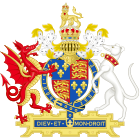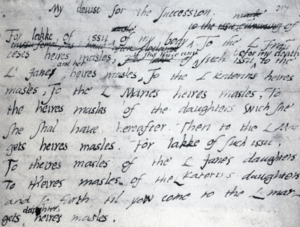Third Succession Act facts for kids

|
|
| Citation | 35 Hen. 8 c. 1 |
|---|---|
| Territorial extent | Kingdom of England |
| Dates | |
| Royal assent | July 1543 |
| Repealed | 1603 |
| Other legislation | |
| Relates to | |
|
Status: Repealed
|
|
| Text of statute as originally enacted | |
The Third Succession Act was an important law made by King Henry VIII of England. It was passed by the Parliament of England in July 1543. This law changed who would become king or queen after Henry VIII.
It put his daughters, Mary and Elizabeth, back in line to the throne. They would follow their younger half-brother, Edward. Edward was born in 1537. He was the son of Henry VIII and his third wife, Jane Seymour. Edward was the first in line to become king.
Contents
History of the Act
What the Act Was Called
This law didn't have a fancy name like laws do today. It was officially known as 35 Hen. 8 c. 1. This means it was the first law passed in the 35th year of King Henry VIII's rule.
Historians often call it the Succession to the Crown Act 1543. Sometimes it's also called the Act of Succession 1543. The King officially approved this law in spring 1544. But back then, laws were often dated to the start of the Parliament session. So, it's usually known as the 1543 Act.
King Henry VIII used these laws to decide who would inherit the throne. He had a complicated family life with many marriages. His first law (25 Hen. VIII c. 22) said that Mary was not a rightful heir. This was after his divorce from Catherine of Aragon. The second law (28 Hen. VIII c. 7) said both Mary and Elizabeth were not rightful heirs. This happened after their mother, Anne Boleyn, was executed. That law said any future children of Henry and his new wife, Jane Seymour, would inherit the throne.
How This Act Changed Things
The Third Succession Act replaced two earlier laws. These were the First Succession Act (1533) and the Second Succession Act (1536). Those earlier laws had said that Henry's daughters, Mary and Elizabeth, could not inherit the throne.
This new law changed that. It put both Mary and Elizabeth back in line to become queen. They would follow Edward, any future children Edward might have, and any future children Henry might have with his wife at the time, Catherine Parr, or any future wife.
The 1536 law had given Henry VIII the power to decide who would inherit the Crown. He could do this using special official documents or in his will. This was if he didn't have any other rightful children after Mary and Elizabeth.
Even with the 1543/44 Act, Mary and Elizabeth were not officially declared rightful heirs from birth. They were only allowed to inherit the Crown. There were some conditions, though. For example, Henry's will of 1547 said they couldn't marry without the approval of the Privy Council. The Privy Council was a group of royal advisors. This meant their place in the line of succession was still a bit uncertain.
What Happened Next
The Treason Act 1547 made it a very serious crime, called high treason, to try and change the line of succession. This line was set by the Act of Succession.
However, Edward VI tried to change this law himself. He wrote a document called his "Devise for the Succession." This document was issued on June 21, 1553. In it, he named Lady Jane Grey as his successor, not his sisters. But in the end, Mary became queen. She did so under the rules of the Third Succession Act.
See also
- Will of Henry VIII of England
- Succession to the British throne
- Alternative successions of the English and British crown


